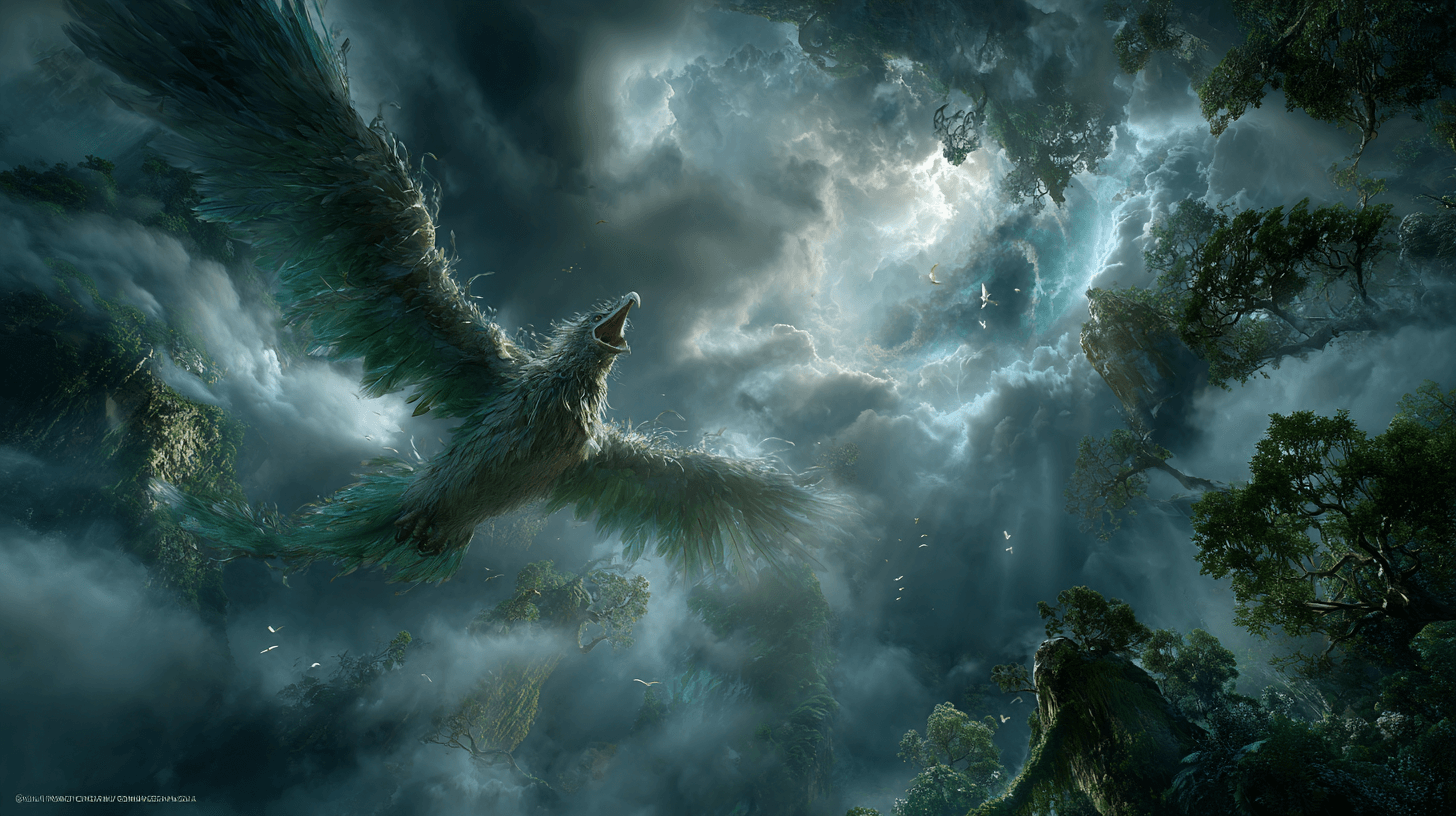Montana’s the kinda place where the mountains swallow secrets, the wind howls old stories, and even the locals can’t agree if that thing they saw in the dusk was just a shadow or somethin’ much stranger. These wilds breed tall tales and mysteries, and let’s be honest—half the fun of livin’ in the Last Best Place is never knowin’ what’s watchin’ from the treeline.
Below, I’ll walk you through the full cryptid roll call—fact, folklore, fable, and everything in between. And if you ain’t spooked by the end, well, maybe you ain’t readin’ close enough.
Shunka Warak’in: Montana’s Original Howler
Native Legends: Warnings in the Night
The Shunka Warak’in legend’s older than barbed wire, stretchin’ back to when Montana was all buffalo and big sky. Lakota and Dakota folks told stories around the fire about a beast that’d come into camp, carry off dogs, and vanish before you could light a torch.[1][2]
This thing wasn’t just an animal—it was a living omen. Sometimes it meant war was coming, or a death in the tribe. It was a test for young braves: face down the Shunka Warak’in, you’d prove your guts to the whole band.
“Soul-Shakin’ Screams” and Prehistoric Power
Old-timers said the Shunka Warak’in’s howl could curdle milk and turn your hair white. Some believe it was a spirit, not flesh and bone. Others swear it’s just a long-lost predator, smarter than your average wolf. Heck, some tribes used scraps of its hide in medicine bundles, hoping to borrow its power for war or hunt.[4][5]
The Ringdocus: Flesh, Bone, and a Whole Lotta Mystery
Now, most cryptids are all talk—nothin’ but “my cousin saw it once in the ‘70s” kind of thing. Not the Shunka Warak’in. In 1886, a tough-as-nails rancher named Israel Hutchins plugged one of these monsters near the Madison Valley. His son remembered the beast thrashin’ ‘til the last breath, “tryin’ to reach any one of us” with a mouth full of teeth.
Sherwood the taxidermist stuffed it, stuck it in his store, and the locals came from all over to see the “Ringdocus.” Was it a hyena? A prehistoric wolf? A freaky hybrid? The thing’s got shoulders like a bison, a sloped back, dark bristly fur—nothin’ quite like it, then or now.[2][4]
The Museum Years: Legend Never Dies
The Ringdocus vanished for decades, hidden away until the Madison Valley History Museum got ahold of it. These days, it’s the pride of Ennis—folks make pilgrimages just to stare into those glassy eyes.[4]
Modern Theories: DNA, Skeptics, and True Believers
Wildlife biologists roll their eyes and say “wolf-dog hybrid,” but even they admit there’s somethin’ a bit “off” about the Ringdocus. DNA testing’s been talked about, but so far, nobody wants to be the one to bust the mystery wide open. After all, half the magic’s in not knowin’ for sure.[7]
Recent “Mystery Wolf” Sightings: In 2018, Montana made national news when a “wolf” was shot that looked downright weird—big paws, odd fur, short legs. DNA said “gray wolf,” but the photo still makes folks uneasy. Legends stick around for a reason.[1][8]
Montana Thunderbirds: Lords of the Sky
Blackfeet and Crow Thunderbird Lore
Thunderbirds ain’t just a tale—they’re a whole belief system. Blackfeet folks tell of Ksiistsikomiipi’kssii—giant birds that live above the clouds, tossin’ thunder and lightning. The Crow tell of feathered monsters that carried off horses and settled ancient scores in the sky. Warriors painted Thunderbirds on their shields, believing the spirit of the storm would protect ‘em in battle.[10][11][12]
Historical Accounts: Up Close with the Impossible
The most famous Montana thunderbird sighting comes from White Bear, a Blackfoot hunter who (supposedly) got carried off to a cliff nest, along with a deer. His wild escape—using thunderbird chicks as makeshift parachutes—sounds crazy, but it’s stuck around in tribal stories for over a century.[12]
Modern Sightings: Even today, Big Sky locals report seeing “giant birds”—sometimes with wingspans 10 to 20 feet—especially during raptor migration season or bad weather. You hear about them around the Bridger Mountains, Pryor Range, or anywhere the horizon seems a bit too big for comfort.
Are Thunderbirds Real? Science vs. Legend
- Skeptics: Giant eagles, golden eagles, or bald eagles—big, but not THAT big.
- Believers: Prehistoric teratorns once roamed North America. Could a relict population survive in the wildest mountains? Stranger things have happened.[12][14][16]
- Others: Maybe it’s just that Montana sky makin’ everything look a little more mysterious.
Blacktail Monster: Shadow of the Dillon Waters
The Pond Where Shadows Swim
Most lake monsters want the spotlight. Not the Blacktail Monster. This critter prefers the quiet waters near Dillon, in Blacktail Pond—a spot more known for kids’ fishing derbies than legendary beasts. Yet locals, especially old-school ranchers and late-night dog walkers, have seen a long, black shape slippin’ just below the surface. [17]
What Locals Claim to See
- An inky shadow that moves against the current, sometimes fast as hell
- A feeling of being watched, especially near dusk or early morning
- Sudden ripples, but never a full sighting—this critter’s all about the tease
Best Guesses: Science, Skepticism, and Suspense
- Biologists: Maybe a lost sturgeon or big ol’ pike
- Fishermen: “It ain’t a trout, and it ain’t an otter”
- Kids: The monster comes out if you leave candy by the shore (hey, let the kids have their fun)
This pond is small, but the mystery’s huge—and that’s why folks keep wanderin’ back for another look.
The “Crazy Woman” of the Crazy Mountains: Haunting the High Country
A True Story Turned Folklore
Ain’t much spookier than the Crazies after sunset. The name itself comes from true stories of settler women who lost everything in the violence of westward expansion. The most famous is Mrs. Morgan—her whole family massacred, she wandered the peaks, mind lost to grief, before dyin’ alone in a crude cabin.[19][21][23]
Sightings: Ghost in the Woods
- Hunters and hikers still hear blood-curdlin’ screams carried on the wind
- Some claim to see a skeletal woman, hair wild, arms outstretched, vanishin’ in the moonlight
- Folks have abandoned cabins after too many sleepless nights and too many “visitors” at the window
Cultural Lessons: Respect for the Land and the Mind
The “Crazy Woman” legend is more than a ghost story. It’s a warning—about the price of trauma, the brutality of frontier life, and the power these mountains have to break even the strongest souls. To this day, it’s a story that makes folks respect mental health as much as they respect bear spray.
Across the Region
Wyoming’s got its own Crazy Woman Creek; North Dakota, too. Same lesson: the wild West took its toll, and the land remembers.[24][26]
The Flathead Lake Monster: Flessie, the Lake’s Gentle Giant
Kutenai Roots and the Lake’s Dark Heart
The Kutenai people told of a creature with antlers that could burst through winter ice and drown half a tribe. That kind of legend sticks around, especially when you live on the biggest natural freshwater lake west of the Mississippi.[28][29][30]
Historic Sightings and the Birth of a Tourist Magnet
1889: Captain Kerr and a boat full of witnesses spot a “whale-like” monster, long as a freight wagon, just cruisin’ the surface. Newspapers eat it up.
Since then, sightings come in steady—sometimes a few a year, sometimes a dozen. Local business owners smile every time someone asks about “Flessie.”[28][32]
Descriptions: What Are Folks Seeing?
- Eel- or serpent-shaped, 20–40 feet, steel-black eyes
- Sometimes rises outta the water, sometimes just a shadow
- More than a few claim to see the monster saving a kid from drowning or just glidin’ peacefully in the dusk
Skeptics and True Believers
- Scientists: Most likely a giant white sturgeon, which can get freakishly big (one was caught in the 1950s—181 pounds!). Or maybe it’s a log, an otter parade, or just wishful thinking.[33]
- Locals: Flessie’s real, and she’s good for business. You’ll find her on pizzas, T-shirts, and bumper stickers all around Flathead Lake.
Flessie: Not Just a Monster, But a Mascot
Flessie ain’t feared—she’s celebrated. Local businesses thrive off her legend, with Flessie-branded goodies, themed festivals, and even Flessie sighting contests in summer.[6][28][34][36]
The Flathead Lakers keep a public sighting archive, and most locals know someone who’s seen “something” out there on the water.
Why Montana’s Cryptids Matter: More Than Just Tall Tales
- Preserving Indigenous Heritage: Most cryptid stories start with Native American legends—our oldest Montana voices.
- Tourism Goldmine: Flessie’s merch alone probably paid for a few college tuitions.
- Respect for the Wild: These legends teach folks to respect the land, the animals, and the mysteries that still hide in the hills.
- Community Identity: Small towns rally around their monsters—keeps people coming back, keeps the coffee hot and the stories fresh.
Expanded FAQ: Montana’s Monsters and Mysteries
Q: Have any cryptids ever hurt anyone in Montana?
A: Not a single proven attack—most are shy, elusive, or downright helpful (lookin’ at you, Flessie).
Q: Where can I learn more or see real cryptid evidence?
A: Start at the Madison Valley History Museum for the Ringdocus, or the Flathead Lakers office for monster reports.
Q: Are there Montana Bigfoot stories?
A: Plenty! From the Yaak to the Bitterroot, Bigfoot’s as much a part of Montana as huckleberries and truck beds. (Want a full blog on that? Just ask.)
Q: How do these legends affect life in Montana today?
A: They bring folks together, keep tourism alive, and add just the right amount of weird to our wild, wonderful state.
Q: Are there cryptid hunting tours?
A: Not “officially,” but join any local at a bar near Flathead Lake, and you’ll get a guided tour of all the best sightin’ spots—plus a beer or two.


Leave a Reply
You must be logged in to post a comment.